Abstract
OBJECTIVE: The recognition that splenectomy renders patients susceptible to lifelong risks of septic complications has led to routine attempts at splenic conservation after trauma. In 1990, the authors reported that over an 11-year study period involving 193 patients, splenorrhaphy was the most common splenic salvage method (66% overall) noted, with nonoperative management employed in only 13% of blunt splenic injuries. This report describes changing patterns of therapy in 190 consecutive patients with splenic injuries seen during a subsequent 6-year period (1990 to 1996). An algorithmic approach for patient management and pitfalls to be avoided to ensure safe nonoperative management are detailed. METHODS: Nonoperative management criteria included hemodynamic stability and computed tomographic examination without shattered spleen or other injuries requiring celiotomy. RESULTS: Of 190 consecutive patients, 102 (54%) were managed nonoperatively: 96 (65%) of 147 patients with blunt splenic injuries, which included 15 patients with intrinsic splenic pathology, and 6 hemodynamically stable patients with isolated stab wounds (24% of all splenic stab wounds). Fifty-six patients underwent splenectomy (29%) and 32 splenorrhaphy (17%). The mean transfusion requirement was 6 units for splenectomy survivors and 0.8 units for nonoperative therapy (85% received no transfusions). Fifteen of the 16 major infectious complications that occurred followed splenectomy. Two patients failed nonoperative therapy (2%) and underwent splenectomy, and one patient required splenectomy after partial splenic resection. There no missed enteric injuries in patients managed nonoperatively. The overall mortality rate was 5.2%, with no deaths following nonoperative management. CONCLUSIONS: Nonoperative management of blunt splenic injuries has replaced splenorrhaphy as the most common method of splenic conservation. The criteria have been extended to include patients previously excluded from this form of therapy. As a result, 65% of all blunt splenic injuries and select stab wounds can be managed with minimal transfusions, morbidity, or mortality, with a success rate of 98%. Splenectomy, when necessary, continues to be associated with excessive transfusion and an inordinately high postoperative sepsis rate.
Full text
PDF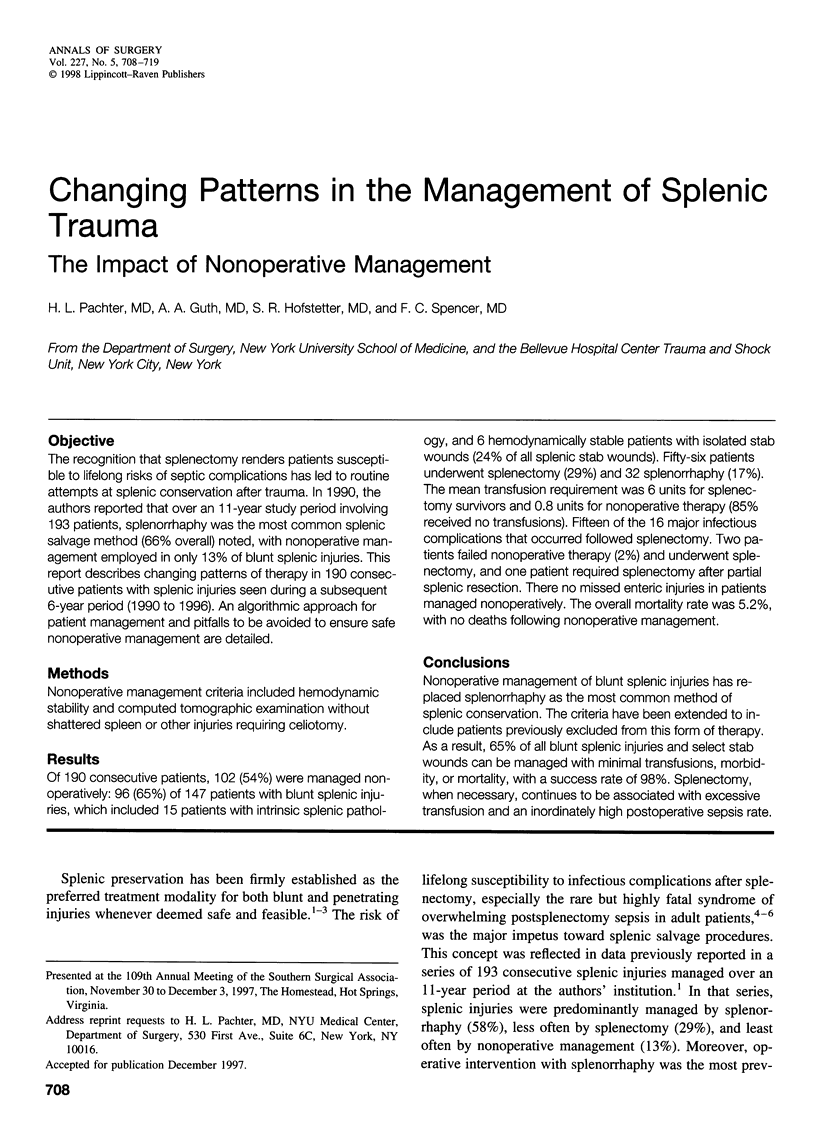

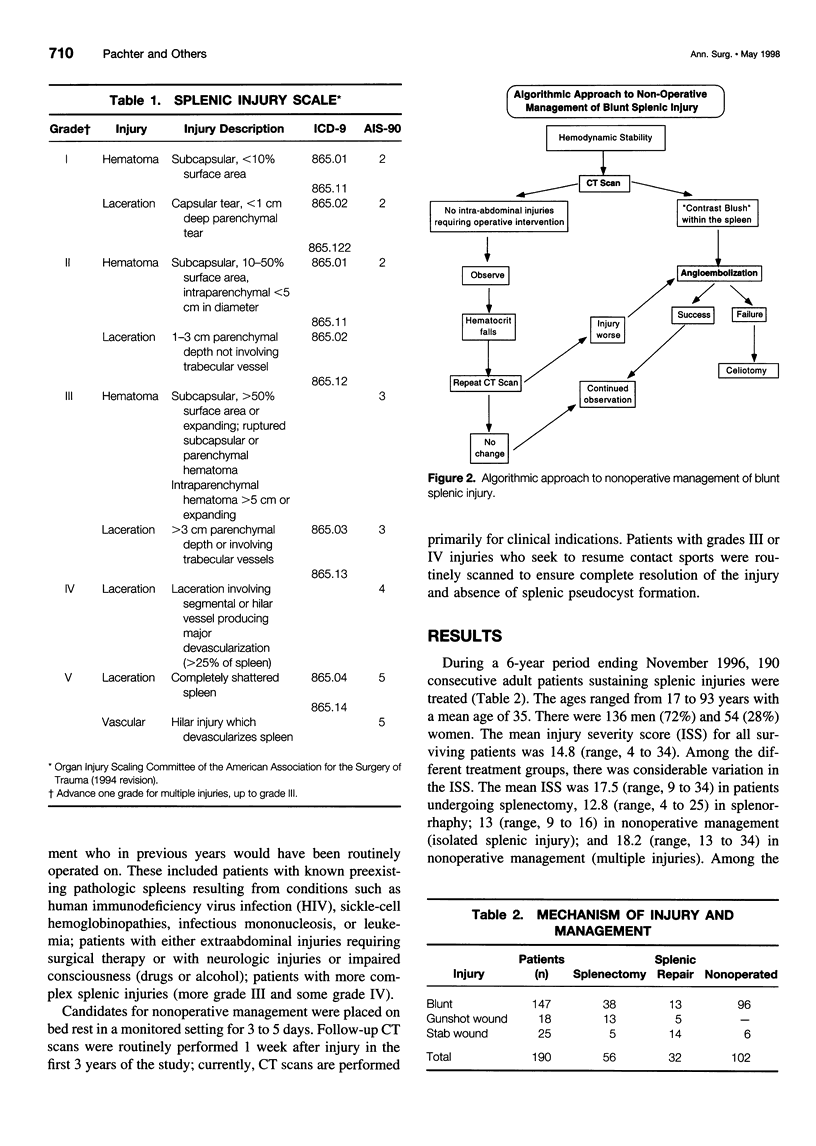

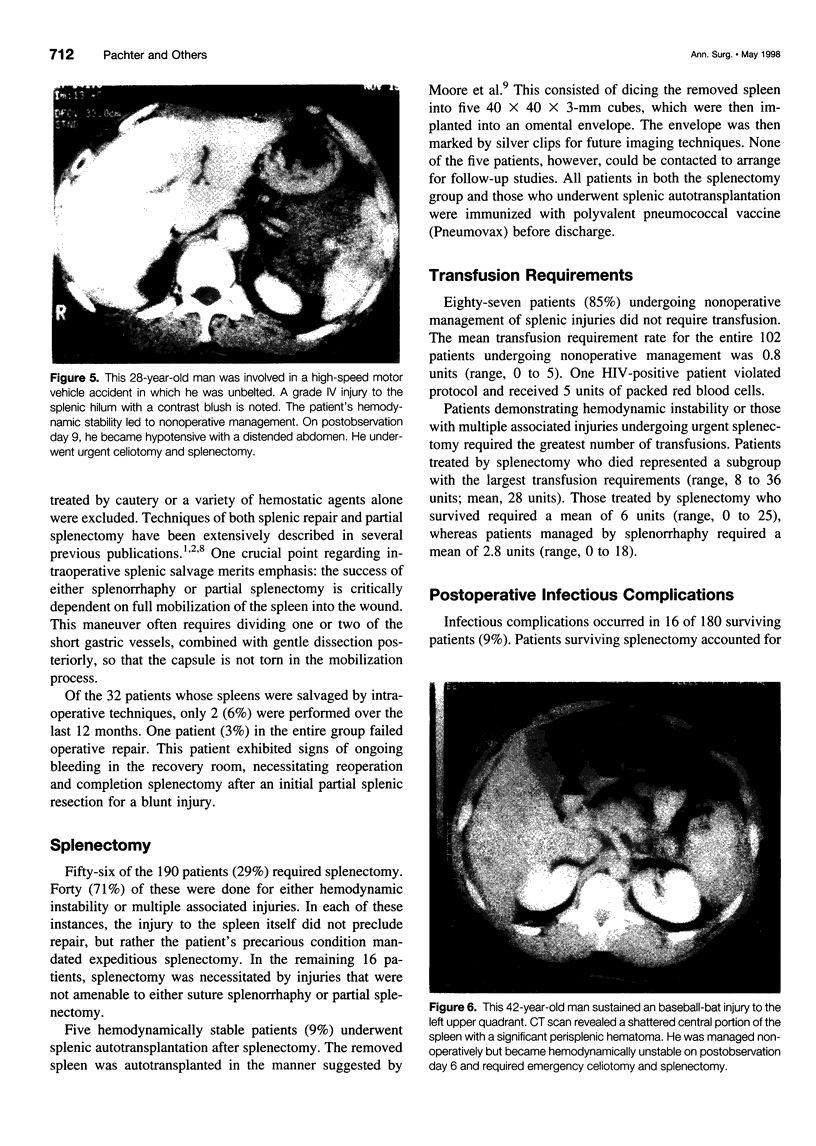
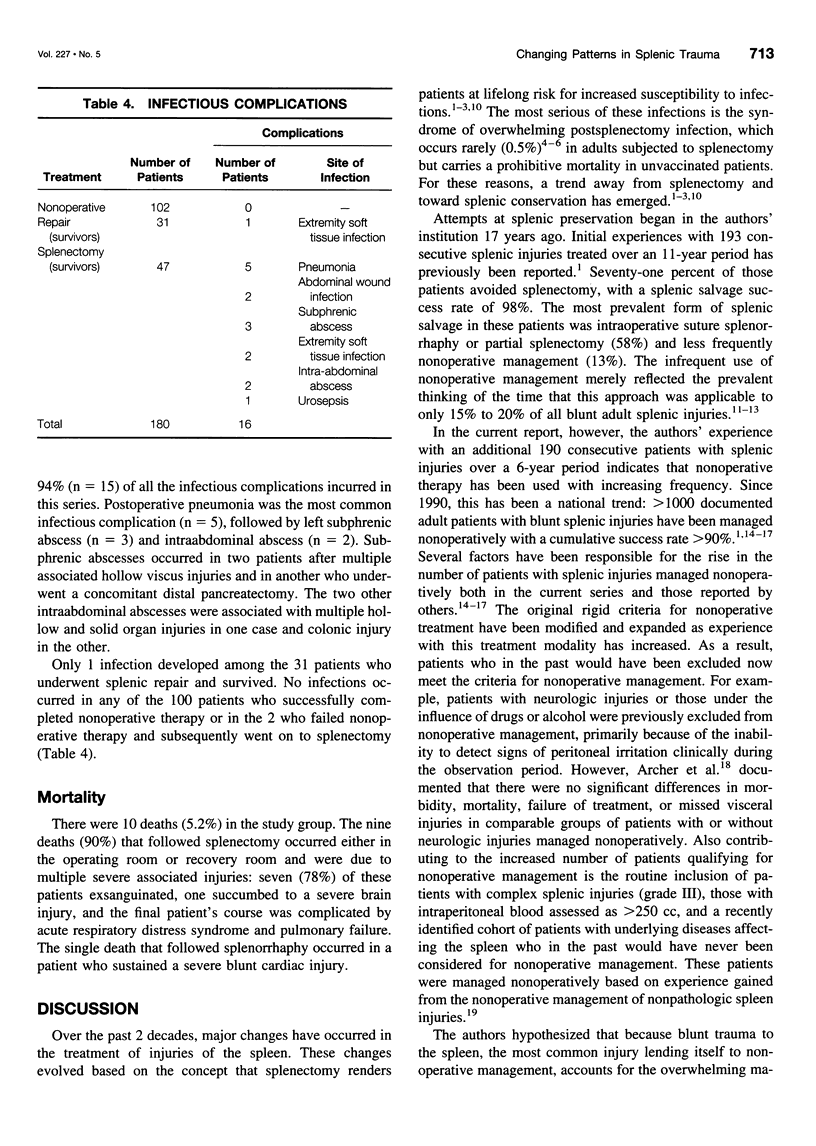
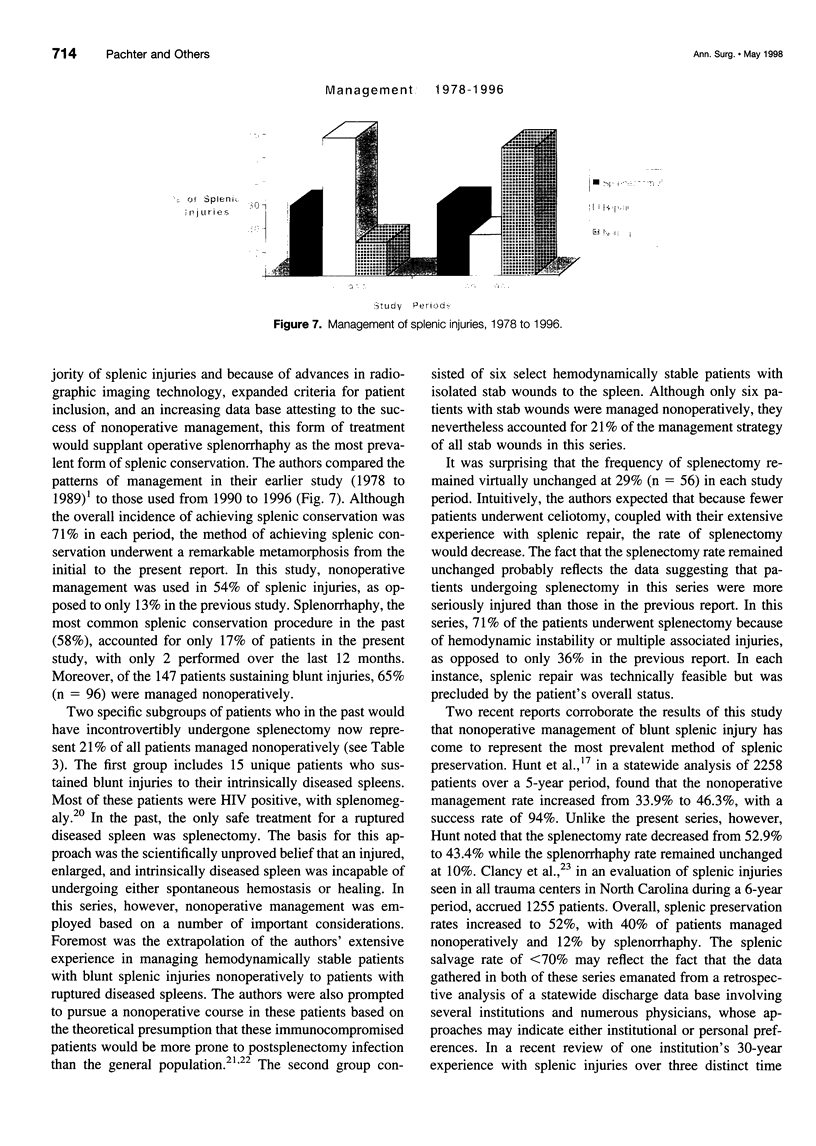
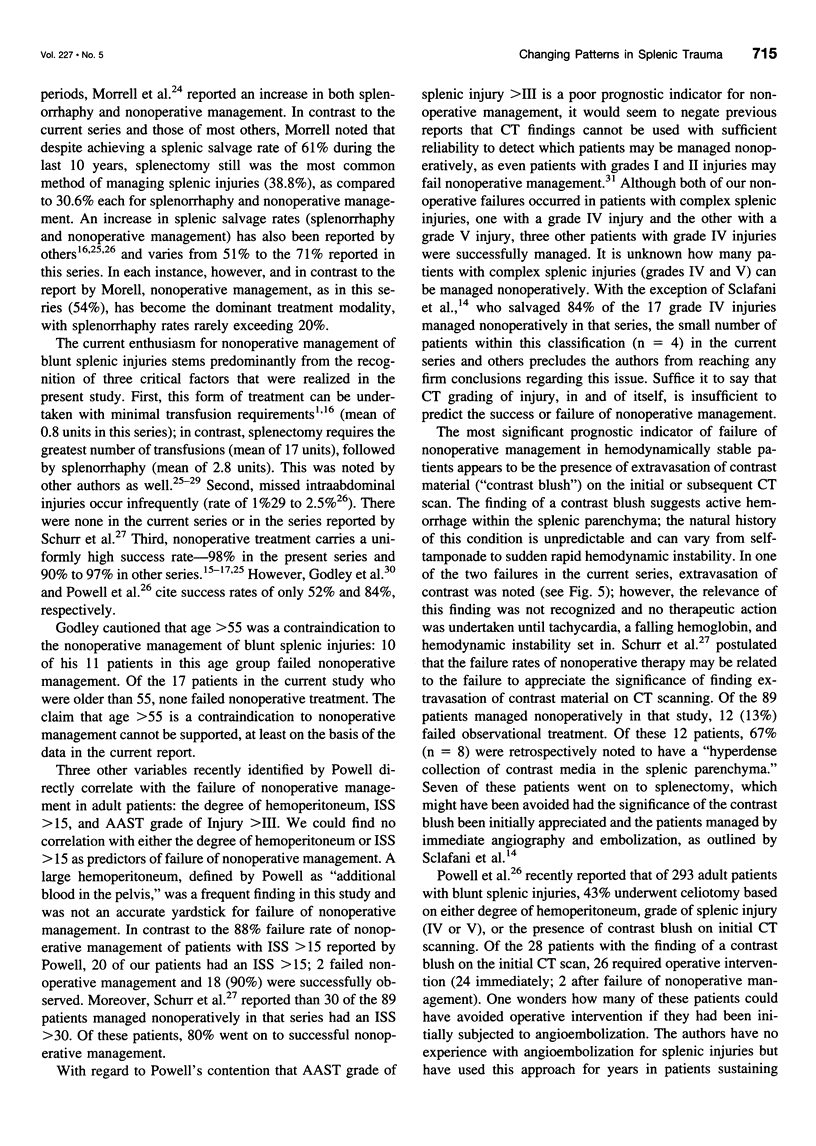
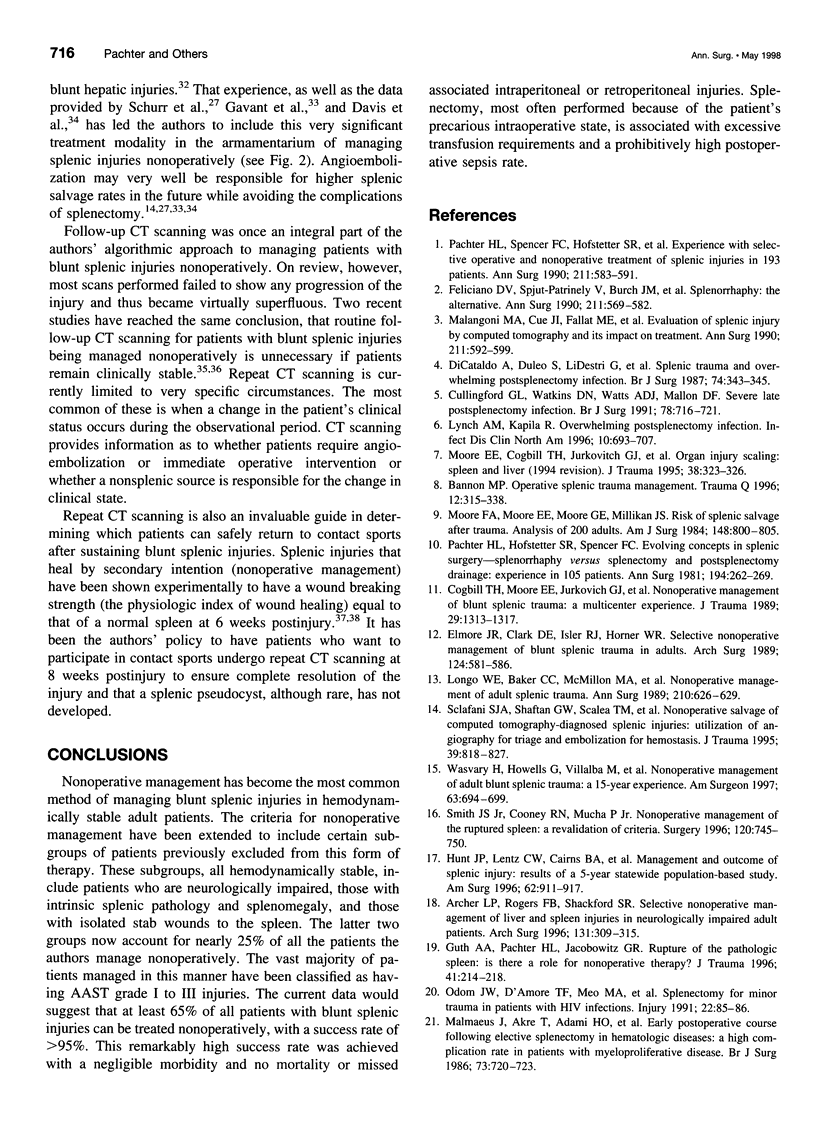

Images in this article
Selected References
These references are in PubMed. This may not be the complete list of references from this article.
- Allins A., Ho T., Nguyen T. H., Cohen M., Waxman K., Hiatt J. R. Limited value of routine followup CT scans in nonoperative management of blunt liver and splenic injuries. Am Surg. 1996 Nov;62(11):883–886. [PubMed] [Google Scholar]
- Archer L. P., Rogers F. B., Shackford S. R. Selective nonoperative management of liver and spleen injuries in neurologically impaired adult patients. Arch Surg. 1996 Mar;131(3):309–315. doi: 10.1001/archsurg.1996.01430150087017. [DOI] [PubMed] [Google Scholar]
- Becker C. D., Spring P., Glättli A., Schweizer W. Blunt splenic trauma in adults: can CT findings be used to determine the need for surgery? AJR Am J Roentgenol. 1994 Feb;162(2):343–347. doi: 10.2214/ajr.162.2.8310923. [DOI] [PubMed] [Google Scholar]
- Bond S. J., Eichelberger M. R., Gotschall C. S., Sivit C. J., Randolph J. G. Nonoperative management of blunt hepatic and splenic injury in children. Ann Surg. 1996 Mar;223(3):286–289. doi: 10.1097/00000658-199603000-00009. [DOI] [PMC free article] [PubMed] [Google Scholar]
- Clancy T. V., Ramshaw D. G., Maxwell J. G., Covington D. L., Churchill M. P., Rutledge R., Oller D. W., Cunningham P. R., Meredith J. W., Thomason M. H. Management outcomes in splenic injury: a statewide trauma center review. Ann Surg. 1997 Jul;226(1):17–24. doi: 10.1097/00000658-199707000-00003. [DOI] [PMC free article] [PubMed] [Google Scholar]
- Cogbill T. H., Moore E. E., Jurkovich G. J., Morris J. A., Mucha P., Jr, Shackford S. R., Stolee R. T., Moore F. A., Pilcher S., LoCicero R. Nonoperative management of blunt splenic trauma: a multicenter experience. J Trauma. 1989 Oct;29(10):1312–1317. doi: 10.1097/00005373-198910000-00002. [DOI] [PubMed] [Google Scholar]
- Cullingford G. L., Watkins D. N., Watts A. D., Mallon D. F. Severe late postsplenectomy infection. Br J Surg. 1991 Jun;78(6):716–721. doi: 10.1002/bjs.1800780626. [DOI] [PubMed] [Google Scholar]
- Di Cataldo A., Puleo S., Li Destri G., Racalbuto A., Trombatore G., Latteri F., Rodolico G. Splenic trauma and overwhelming postsplenectomy infection. Br J Surg. 1987 May;74(5):343–345. doi: 10.1002/bjs.1800740504. [DOI] [PubMed] [Google Scholar]
- Dulchavsky S. A., Lucas C. E., Ledgerwood A. M., Grabow D. Wound healing of the injured spleen with and without splenorrhaphy. J Trauma. 1987 Oct;27(10):1155–1160. doi: 10.1097/00005373-198710000-00010. [DOI] [PubMed] [Google Scholar]
- Elmore J. R., Clark D. E., Isler R. J., Horner W. R. Selective nonoperative management of blunt splenic trauma in adults. Arch Surg. 1989 May;124(5):581–586. doi: 10.1001/archsurg.1989.01410050071015. [DOI] [PubMed] [Google Scholar]
- Feliciano D. V., Spjut-Patrinely V., Burch J. M., Mattox K. L., Bitondo C. G., Cruse-Martocci P., Jordan G. L., Jr Splenorrhaphy. The alternative. Ann Surg. 1990 May;211(5):569–582. doi: 10.1097/00000658-199005000-00007. [DOI] [PMC free article] [PubMed] [Google Scholar]
- Garber B. G., Yelle J. D., Fairfull-Smith R., Lorimer J. W., Carson C. Management of splenic injuries in a Canadian trauma centre. Can J Surg. 1996 Dec;39(6):474–480. [PMC free article] [PubMed] [Google Scholar]
- Gavant M. L., Schurr M., Flick P. A., Croce M. A., Fabian T. C., Gold R. E. Predicting clinical outcome of nonsurgical management of blunt splenic injury: using CT to reveal abnormalities of splenic vasculature. AJR Am J Roentgenol. 1997 Jan;168(1):207–212. doi: 10.2214/ajr.168.1.8976947. [DOI] [PubMed] [Google Scholar]
- Godley C. D., Warren R. L., Sheridan R. L., McCabe C. J. Nonoperative management of blunt splenic injury in adults: age over 55 years as a powerful indicator for failure. J Am Coll Surg. 1996 Aug;183(2):133–139. [PubMed] [Google Scholar]
- Guth A. A., Pachter H. L., Jacobowitz G. R. Rupture of the pathologic spleen: is there a role for nonoperative therapy? J Trauma. 1996 Aug;41(2):214–218. doi: 10.1097/00005373-199608000-00003. [DOI] [PubMed] [Google Scholar]
- Hunt J. P., Lentz C. W., Cairns B. A., Ramadan F. M., Smith D. L., Rutledge R., Meyer A. A., Fakhry S. M. Management and outcome of splenic injury: the results of a five-year statewide population-based study. Am Surg. 1996 Nov;62(11):911–917. [PubMed] [Google Scholar]
- Jalovec L. M., Boe B. S., Wyffels P. L. The advantages of early operation with splenorrhaphy versus nonoperative management for the blunt splenic trauma patient. Am Surg. 1993 Oct;59(10):698–705. [PubMed] [Google Scholar]
- Johansson T., Boström H., Sjödahl R., Ihse I. Splenectomy for haematological diseases. Acta Chir Scand. 1990 Jan;156(1):83–86. [PubMed] [Google Scholar]
- Lawson D. E., Jacobson J. A., Spizarny D. L., Pranikoff T. Splenic trauma: value of follow-up CT. Radiology. 1995 Jan;194(1):97–100. doi: 10.1148/radiology.194.1.7997589. [DOI] [PubMed] [Google Scholar]
- Longo W. E., Baker C. C., McMillen M. A., Modlin I. M., Degutis L. C., Zucker K. A. Nonoperative management of adult blunt splenic trauma. Criteria for successful outcome. Ann Surg. 1989 Nov;210(5):626–629. doi: 10.1097/00000658-198911000-00010. [DOI] [PMC free article] [PubMed] [Google Scholar]
- Lynch A. M., Kapila R. Overwhelming postsplenectomy infection. Infect Dis Clin North Am. 1996 Dec;10(4):693–707. doi: 10.1016/s0891-5520(05)70322-6. [DOI] [PubMed] [Google Scholar]
- Malangoni M. A., Cué J. I., Fallat M. E., Willing S. J., Richardson J. D. Evaluation of splenic injury by computed tomography and its impact on treatment. Ann Surg. 1990 May;211(5):592–599. doi: 10.1097/00000658-199005000-00009. [DOI] [PMC free article] [PubMed] [Google Scholar]
- Malmaeus J., Akre T., Adami H. O., Hagberg H. Early postoperative course following elective splenectomy in haematological diseases: a high complication rate in patients with myeloproliferative disorders. Br J Surg. 1986 Sep;73(9):720–723. doi: 10.1002/bjs.1800730915. [DOI] [PubMed] [Google Scholar]
- Moore E. E., Cogbill T. H., Jurkovich G. J., Shackford S. R., Malangoni M. A., Champion H. R. Organ injury scaling: spleen and liver (1994 revision). J Trauma. 1995 Mar;38(3):323–324. doi: 10.1097/00005373-199503000-00001. [DOI] [PubMed] [Google Scholar]
- Moore F. A., Moore E. E., Moore G. E., Millikan J. S. Risk of splenic salvage after trauma. Analysis of 200 adults. Am J Surg. 1984 Dec;148(6):800–805. doi: 10.1016/0002-9610(84)90441-0. [DOI] [PubMed] [Google Scholar]
- Morrell D. G., Chang F. C., Helmer S. D. Changing trends in the management of splenic injury. Am J Surg. 1995 Dec;170(6):686–690. doi: 10.1016/s0002-9610(99)80042-7. [DOI] [PubMed] [Google Scholar]
- Odom J. W., D'Amore T. F., Meo M. A., Lobbato V. Splenectomy for minor splenic trauma in patients with HIV infections. Injury. 1991 Mar;22(2):85–86. doi: 10.1016/0020-1383(91)90060-r. [DOI] [PubMed] [Google Scholar]
- Pachter H. L., Hofstetter S. R., Spencer F. C. Evolving concepts in splenic surgery: splenorrhaphy versus splenectomy and postsplenectomy drainage: experience in 105 patients. Ann Surg. 1981 Sep;194(3):262–269. doi: 10.1097/00000658-198109000-00003. [DOI] [PMC free article] [PubMed] [Google Scholar]
- Pachter H. L., Knudson M. M., Esrig B., Ross S., Hoyt D., Cogbill T., Sherman H., Scalea T., Harrison P., Shackford S. Status of nonoperative management of blunt hepatic injuries in 1995: a multicenter experience with 404 patients. J Trauma. 1996 Jan;40(1):31–38. doi: 10.1097/00005373-199601000-00007. [DOI] [PubMed] [Google Scholar]
- Pachter H. L., Spencer F. C., Hofstetter S. R., Liang H. G., Hoballah J., Coppa G. F. Experience with selective operative and nonoperative treatment of splenic injuries in 193 patients. Ann Surg. 1990 May;211(5):583–591. doi: 10.1097/00000658-199005000-00008. [DOI] [PMC free article] [PubMed] [Google Scholar]
- Powell M., Courcoulas A., Gardner M., Lynch J., Harbrecht B. G., Udekwu A. O., Billiar T. R., Federle M., Ferris J., Meza M. P. Management of blunt splenic trauma: significant differences between adults and children. Surgery. 1997 Oct;122(4):654–660. doi: 10.1016/s0039-6060(97)90070-2. [DOI] [PubMed] [Google Scholar]
- Schurr M. J., Fabian T. C., Gavant M., Croce M. A., Kudsk K. A., Minard G., Woodman G., Pritchard F. E. Management of blunt splenic trauma: computed tomographic contrast blush predicts failure of nonoperative management. J Trauma. 1995 Sep;39(3):507–513. doi: 10.1097/00005373-199509000-00018. [DOI] [PubMed] [Google Scholar]
- Sclafani S. J., Shaftan G. W., Scalea T. M., Patterson L. A., Kohl L., Kantor A., Herskowitz M. M., Hoffer E. K., Henry S., Dresner L. S. Nonoperative salvage of computed tomography-diagnosed splenic injuries: utilization of angiography for triage and embolization for hemostasis. J Trauma. 1995 Nov;39(5):818–827. doi: 10.1097/00005373-199511000-00004. [DOI] [PubMed] [Google Scholar]
- Smith J. S., Jr, Cooney R. N., Mucha P., Jr Nonoperative management of the ruptured spleen: a revalidation of criteria. Surgery. 1996 Oct;120(4):745–751. doi: 10.1016/s0039-6060(96)80026-2. [DOI] [PubMed] [Google Scholar]
- Wasvary H., Howells G., Villalba M., Madrazo B., Bendick P., DeAngelis M., Bair H., Lucas R. Nonoperative management of adult blunt splenic trauma: a 15-year experience. Am Surg. 1997 Aug;63(8):694–699. [PubMed] [Google Scholar]







